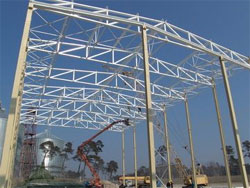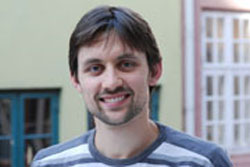Baltic Sea region needs cooperation, not nationalism
on
Baltic Sea region needs cooperation, not nationalism
The countries around the Baltic Sea would do well to integrate their energy policies as much as possible with each other. Only in this way will it be possible for them to integrate large-scale renewable energies, such as offshore wind power, into their energy mix in an economical way.
 |
| Construction of a new biodiesel plant in Latvia by Bio-Venta. |
The most important conclusion from the 2009 report, says Anders Kofoed-Wiuff, energy analyst from Ea Energianalyse, and one of the authors, was that the Baltic Sea region has a large potential for the development of renewable energies. ‘For example, the relative biomass resource in the region is twice as great as for the EU as a whole. It also has great offshore wind potential and large hydro resources in some countries. This gives the Baltic region an excellent basis to turn itself into a “green” region. We concluded that it is very well possible to achieve a 50% reduction of CO2-emissions by 2030.’
Since the completion of this study, ‘ the political agenda has developed further in the region’, says Kofoed-Wiuff. ‘ Many of the countries around the Baltic Sea have been working out their energy visions. Their focus is even more on the development of renewable energy. A number of plans for new electricity and gas interconnectors are being refined.’
In addition, the analyst notes that a number of new power generation units are at the planning stage in the Baltic countries, in Kaliningrad, which is part of Russia, and in Northwest Russia. Unfortunately, he adds, ‘these plans are likely to be developed without systematic and coherent regional planning. On the contrary, the investment plans have often been strongly politicised.’ One example is the plan for a new thermal power plant in Latvia, which is ‘based not on pure market economics, but on a self-sufficiency agenda’.
Another well-known example are the various plans for new nuclear power plants in the region, in particular the Russian plan to build a nuclear power plant in Kaliningrad and the Lithuanian project to build a nuclear replacement for the Ignalina nuclear power plant, which was closed at the end of 2009. The closure of Ignalina was demanded by Brussels as a condition for Lithuania to join the EU, much to the chagrin of the Lithuanians. The Lithuanian government insists it intends to build a large new nuclear plant of 3400 MW at Visaginas near Ignalina, possibly in cooperation with Poland and the other Baltic States, but has not found any investors yet. The Russian announcement of new nuclear build in Kaliningrad represents a serious problem for the Lithuanians. ‘It is difficult to see that there would be room for two new nuclear power plants in that part of the region’, says Kofoed-Wiuff. To make matters worse, Finland is also building a new nuclear power station and Poland and Belarus also have plans in this direction.
 |
| Anders Kofoed-Wiuff, energy analyst at Ea Energianalyse |
Kofoed-Wiuff notes that the 2010 study for the first time includes official and reliable production and transmission data from North-West Russia. ‘So far this information has been available only to a very few decision-makers at the highest level. Thanks to our close contacts to regional authorities and electricity companies in North-West Russia we have now been able to develop a unique picture of the regional energy situation.’ The new details will become available when the first results are made public in Vilnius. Using the feed-back from the BDF Summit we expect to have a final report published by the end of June’.
On the table
According to Kofoed-Wiuff, the model tools developed by Ea could help the countries in the region to come to a comprehensive planning. This is particularly important to make possible the large-scale development of offshore wind farms in the Baltic Sea. ‘There is quite a lot of interest from investors and developers to build offshore wind power, but this cannot be done economically at a national level. You have to approach this internationally. The Danish wind power success would not have been possible either if Denmark had been self-sufficient.’
The integration of trading markets would yield large benefits at virtually no extra cost, says Kofoed-Wiuff. The building of interconnectors and international transmission capacity requires investments, but it would be profitable in the longer term.
Kofoed-Wiuff is optimistic about the way in which the energy market in the Baltic Sea Region is developing, for one thing because the EU has come out to support regional integration with the adoption of the Baltic Energy Market Interconnection Plan (BEMIP). Particularly important is the decision by the EU, in the framework of BEMIP, to back Estlink Two, a 650 MW submarine cable which will connect Estonia with Finland, and Nordbalt, a 700-1000 MW submarine cable that will connect Sweden with Lithuania. Another important regional project, says Kofoed-Wiuff, is Kriegers Flak, a plan to connect 1600 MW offshore wind power in the Baltic Sea to Germany, Sweden and Denmark, and to provide additional transmission capacity between these countries.
‘The EU is beginning to fulfill its role here’, says Kofoed-Wiuff. ‘It has put money on the table. This is making the process of regional integration a lot easier.’
|
For earlier stories in European Energy Review on the Baltic energy market, see Energy fever in the Baltics, Lithuania’s nuclear power dreams and Baltic states torn between two lovers. For more information on the Baltic Energy Market Interconnection Plan (BEMIP), see the following pages on the website of the European Commission: For more information on the Baltic Development Forum see: |


Discussion (0 comments)